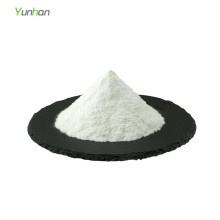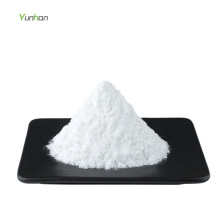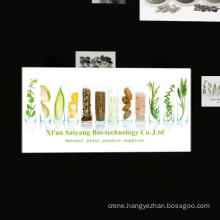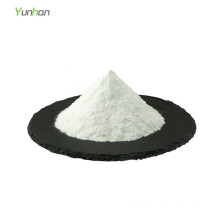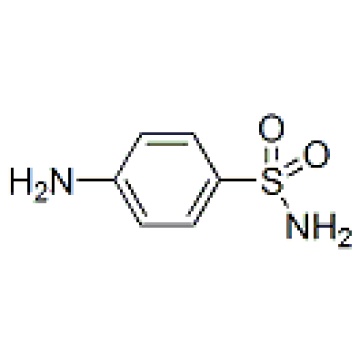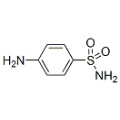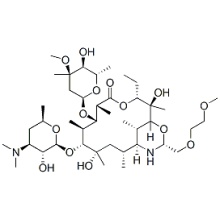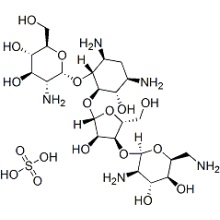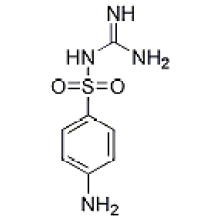Sulfanilamide 63-74-1
Product Description
.cp_wz table {border-top: 1px solid #ccc;border-left:1px solid #ccc; } .cp_wz table td{border-right: 1px solid #ccc; border-bottom: 1px solid #ccc; padding: 5px 0px 0px 5px;} .cp_wz table th {border-right: 1px solid #ccc;border-bottom: 1px solid #ccc; padding: 5px 0px 0px 5px;}
Molecular Weight: 172.2 Sulfanilamide (Sulphanilamide) is a competitive inhibitor for bacterial enzyme dihydropteroate synthetase with IC50 of 320 μM.
Biological Activity
Sulfanilamide containing the sulfonamide functional group displays
inhibitory activity for dihydropteroate synthetase partially purified
from Escherichia coli which normally uses para-aminobenzoic acid (PABA)
for synthesizing the necessary folic acid acting as a coenzyme in the
synthesis of purine, pyrimidine and other Amino Acids, exhibiting an IC
50 of 320 μM for dihydropteroate synthetasea and Km of 2.5 uM for PABA.
Sulfanilamide shows IC50 of 286.8 μg/mL for recombinant S.
cerevisiae
strains with wild-type FOL1 genes, but the single mutation 55Trp to 55Ala or 57Pro to 57Ser within the putative active site of the fungal DHPS confers resistance to Sulfanilamide with IC50 of >800 μg/mL.
Sulfanilamide moderately inhibits the growth of bacterial cells
harboring plasmodium falciparum pKOS-pfPPPK-DHPS (His) with IC50 of 380
uM.
Administration of Sulfanilamide with the dosage of 100 mg/kg/day is
effective in the prevention of P. carinii infection in the
immunosuppressed rat model. When the dosage of sulfaguanidine and
Sulfanilamide reduced to 10 mg/kg/day, breakthrough P. carinii infection
occurs in the rats.
Protocol(Only for Reference)
Kinase Assay: [1]
Animal Study: [4]
Conversion of different model animals based on BSA (Value based on data from FDA Draft Guidelines)
For example, to modify the dose of resveratrol used for a mouse (22.4 mg/kg) to a dose based on the BSA for a rat, multiply 22.4 mg/kg by the Km factor for a mouse and then divide by the Km factor for a rat. This calculation results in a rat equivalent dose for resveratrol of 11.2 mg/kg.
Chemical Information
Molarity Calculator
Dilution Calculator
Molecular Weight Calculator
Contact us if you need more details on Sulfanilamide. We are ready to answer your questions on packaging, logistics, certification or any Other aspects about 63-74-1 Sulfanilamide、63-74-1. If these products fail to match your need, please contact us and we would like to provide relevant information.
Molecular Weight: 172.2 Sulfanilamide (Sulphanilamide) is a competitive inhibitor for bacterial enzyme dihydropteroate synthetase with IC50 of 320 μM.
Biological Activity
Sulfanilamide containing the sulfonamide functional group displays
inhibitory activity for dihydropteroate synthetase partially purified
from Escherichia coli which normally uses para-aminobenzoic acid (PABA)
for synthesizing the necessary folic acid acting as a coenzyme in the
synthesis of purine, pyrimidine and other Amino Acids, exhibiting an IC
50 of 320 μM for dihydropteroate synthetasea and Km of 2.5 uM for PABA.
Sulfanilamide shows IC50 of 286.8 μg/mL for recombinant S.
cerevisiae
strains with wild-type FOL1 genes, but the single mutation 55Trp to 55Ala or 57Pro to 57Ser within the putative active site of the fungal DHPS confers resistance to Sulfanilamide with IC50 of >800 μg/mL.
Sulfanilamide moderately inhibits the growth of bacterial cells
harboring plasmodium falciparum pKOS-pfPPPK-DHPS (His) with IC50 of 380
uM.
Administration of Sulfanilamide with the dosage of 100 mg/kg/day is
effective in the prevention of P. carinii infection in the
immunosuppressed rat model. When the dosage of sulfaguanidine and
Sulfanilamide reduced to 10 mg/kg/day, breakthrough P. carinii infection
occurs in the rats.
Protocol(Only for Reference)
Kinase Assay: [1]
| Assay of dihydropteroate synthetase activity | The dihydropteroate synthetase activity is measured by a modification of the radioactive assay based on the incorporation of 14C-PABA into dihydropteroate. The reaction mixture in test tubes (1 by 7 cm) is prepared in 0.4 mL of 100 mM Tris-HCl buffer (pH 8.5) (containing 10 mM of MgCl2, 50 mM of 2-ME, 0.12 mM of hydroxymethyldihydropteridine pyrophosphate, 0.01 mM of 14C-PABA, a set of concentrations of Sulfanilamide and 0.2 mg partially purified dihydropteroate synthetase extract), and incubated for 1 hour at 37 °C. The reactions are stopped immediately by the addition of 25 μM of EDTA (pH 8.3) to each reaction mixture, then evaporated to dryness under reduced pressure and redissolved in 0.075 mL of 0.05 M Tris (pH 8.0). 0.05 mL of the above mixture is applied (each in an area of 1.0 by 4.0 cm) to Whatman 3MM chromatography paper. The chromatograms are developed by descending chromatography with 0.1 M potassium phosphate buffer (pH 7.0), for 4 hours at 25 °C. Under these conditions, pteroate (dihydropteroate is oxidized to pteroate during the evaporation step) remains at the origin, whereas unreacted 14C-PABA migrates with an Rf value of 0.78. Areas corresponding to the origin of the developed chromatograms are cut out and counted in a liquid scintillation counter. The concentration of Sulfanilamide required for 50% inhibition of dihydropteroate synthetase activity represents IC50. |
|---|
Animal Study: [4]
| Animal Models | Male Sprague-Dawley rats | ||
|---|---|---|---|
| Formulation | Thoroughly mixed into the daily ration of pulverized food and compounded into pellets. | ||
| Dosages | 100 mg/kg | ||
| Administration | Orally taken every day | ||
| Solubility | 30% PEG400/0.5% Tween80/5% propylene glycol, 30 mg/mL | ||
| * Please note that Selleck tests the solubility of all compounds in-house, and the actual solubility may differ slightly from published values. This is normal and is due to slight batch-to-batch variations. | |||
Conversion of different model animals based on BSA (Value based on data from FDA Draft Guidelines)
| Species | Baboon | Dog | Monkey | Rabbit | Guinea pig | Rat | Hamster | Mouse |
| Weight (kg) | 12 | 10 | 3 | 1.8 | 0.4 | 0.15 | 0.08 | 0.02 |
| Body Surface Area (m2) | 0.6 | 0.5 | 0.24 | 0.15 | 0.05 | 0.025 | 0.02 | 0.007 |
| Km factor | 20 | 20 | 12 | 12 | 8 | 6 | 5 | 3 |
| Animal A (mg/kg) = Animal B (mg/kg) multiplied by | Animal B Km |
| Animal A Km |
For example, to modify the dose of resveratrol used for a mouse (22.4 mg/kg) to a dose based on the BSA for a rat, multiply 22.4 mg/kg by the Km factor for a mouse and then divide by the Km factor for a rat. This calculation results in a rat equivalent dose for resveratrol of 11.2 mg/kg.
| Rat dose (mg/kg) = mouse dose (22.4 mg/kg) × | mouse Km(3) | = 11.2 mg/kg |
| rat Km(6) |
Chemical Information
| Molecular Weight (MW) | 172.2 |
|---|---|
| Formula | C6H8N2O2S |
| CAS No. | 63-74-1 |
| Storage | 3 years -20℃Powder |
|---|---|
| 6 months-80℃in solvent (DMSO, water, etc.) | |
| Synonyms | |
| Solubility (25°C) * | In vitro | DMSO | 34 mg/mL (197.44 mM) |
|---|---|---|---|
| Water | <1 mg/mL ( | ||
| Ethanol | 17 mg/mL (98.72 mM) | ||
| In vivo | 30% PEG400/0.5% Tween80/5% propylene glycol | 30 mg/mL | |
| * <1 mg/ml means slightly soluble or insoluble. * Please note that Selleck tests the solubility of all compounds in-house, and the actual solubility may differ slightly from published values. This is normal and is due to slight batch-to-batch variations. | |||
| Chemical Name | 4-amino-benzenesulfonamide |
|---|
Molarity Calculator
Dilution Calculator
Molecular Weight Calculator
Contact us if you need more details on Sulfanilamide. We are ready to answer your questions on packaging, logistics, certification or any Other aspects about 63-74-1 Sulfanilamide、63-74-1. If these products fail to match your need, please contact us and we would like to provide relevant information.
Other Products
Hot Products
Astragaloside AChlortetracycline HCl 64-72-2Paclitaxel 33069-62-4Dexamethasone Acetate 1177-87-3Dinaciclib (SCH727965) 779353-01-4CHIR-124 405168-58-3Ro3280 1062243-51-9TAME 901-47-3CCG-1423 285986-88-110058-F4 403811-55-2Dabigatran (BIBR 953) 211914-51-1H 89 2HCl 130964-39-5T0901317 293754-55-9Aprepitant 170729-80-3Turofexorate Isopropyl (XL335) 629664-81-9BMS-378806 357263-13-9
